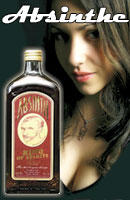 Absinthe??? Jeebus, I thought this went out with Paul Valery, or at least John Paul (II) Sartre. Pictures of grungy French Cafes with slouchy spy type individuals (alright, I did read a lot of Alan Furst recently). You, of course, knew that Absinthe is also known under the rubric Wormwood. (Sounds like a C.S. Lewis character, or at least something out of Milton.)
Absinthe??? Jeebus, I thought this went out with Paul Valery, or at least John Paul (II) Sartre. Pictures of grungy French Cafes with slouchy spy type individuals (alright, I did read a lot of Alan Furst recently). You, of course, knew that Absinthe is also known under the rubric Wormwood. (Sounds like a C.S. Lewis character, or at least something out of Milton.)Apparently, absinthe is all the rage in the jet set these days.
I can't imagine why.
Absinthe, the emerald green liqueur associated with excess, is back in business. Having been banned in many countries in the early 20th century, its newly fashionable image...
Originally formulated in Switzerland, absinthe became most popular in 19th century France. Between 1875 and 1913 French consumption of the liquor increased 15-fold. It became an icon of "la vie de bohème," and in fin-de-siècle Paris 'heure verte' (the green [cocktail] hour) was a daily event. Although never as popular in Britain, the fashion of mixed drinks with a "spot" or "kick" of absinthe was reported in London as late as 1930.
Many creative artists had their lives touched by absinthe (Toulouse-Lautrec, Oscar Wilde, Picasso). The illness of Vincent van Gogh was certainly exacerbated by excessive drinking of absinthe...
Absinthism was associated with gastrointestinal problems, acute auditory and visual hallucinations, epilepsy, brain damage, and increased risk of psychiatric illness and suicide..
Acute auditory and visual hallucinations sounds familiar. Try this link that someone gave me:
http://www.imgag.com/product/full/ap/3067907/graphic1.swf
Absinthe and wormwood contain thujone. This is the neurotoxic component and, you know, people like their neurotoxins, preferably neat. We even have high Science weighing in:
alpha-Thujone (the active component of absinthe): gamma-Aminobutyric acid type A receptor modulation and metabolic detoxification.
...observations establish that alpha-thujone is a modulator of the gamma-aminobutyric acid (GABA) type A receptor. First, the poisoning signs (and their alleviation by diazepam and phenobarbital) in mice are similar to those of the classical antagonist picrotoxinin.
I just don't think I'm interested. I'd rather not be terminally cool.
4 comments:
I think you have mixed up a lot of stories (I noticed you stopped on the ad with the beautiful woman though...good job).
To wit: Wormwood was a character (clumsy spy) in the Eiger Sanction. That's Trevanian, not C.S. Lewis, and certainly not Milton. Take heart though with all your poison explanation...the protaganist's name in that book is Hemlock. Wormood though is slouchy, but in Montreal not Paris.
Close enough? Check this:http://www.ereader.com/product/book/excerpt/19250?book=The_Eiger_Sanction:_A_Novel
I beg your pardon:
http://www.philosophyofreligion.info/lewis.html
C.S. Lewis
The Screwtape Letters
Another firm favourite of Lewis fans is his satire The Screwtape Letters, a brilliant (and humorous) collection of letters of advice written by the demon Screwtape to his apprentice and nephew Wormwood.
And:
http://www.daypoems.net/poems/1013.html
"Still rule those minds on earth
At whom sage Milton's wormwood words were hurled:
'Truth like a bastard comes into the world
Never without ill-fame to him who gives her birth'?"
As I was saying....
"Absinthism was associated with gastrointestinal problems, acute auditory and visual hallucinations, epilepsy, brain damage, and increased risk of psychiatric illness and suicide.."
Cuervo and a joint, end of discussion.
...ah, but where is the slouchy spy in French locale in those?
Red...great idea! Bring the girl in the ad.
Post a Comment